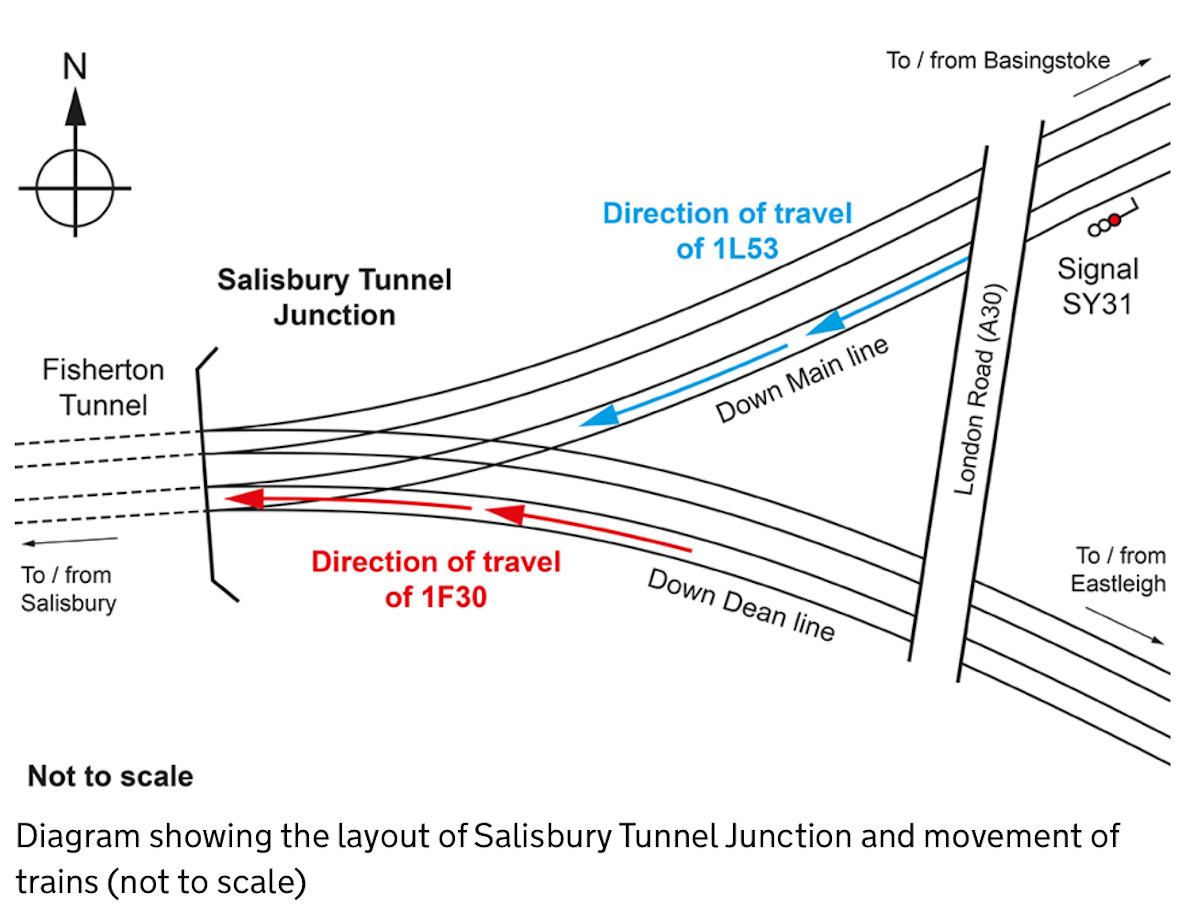by the Rail Accident Investigation Branch on 3rd November 2021.
Collision between passenger trains at Salisbury Tunnel Junction
Investigation into a collision between passenger trains at Salisbury Tunnel Junction, Wiltshire, 31 October 2021
At around 18:45 hrs on 31 October 2021, train reporting number 1L53, the 17:20 hrs South Western Railway passenger service from London Waterloo to Honiton, collided with the side of train 1F30, the 17:08 hrs Great Western Railway passenger service from Portsmouth Harbour to Bristol Temple Meads. The collision took place at Salisbury Tunnel Junction, which is on the immediate approach to Fisherton Tunnel, near Salisbury in Wiltshire.
This junction allows the Up and Down Dean lines which lead to and from Eastleigh to merge with the Up and Down Main lines which lead to and from Basingstoke. At the time of the accident train 1F30 was using the junction to join the Down Main line from the Down Dean line, while train 1L53 was approaching the junction on the Down Main line from the direction of Basingstoke.

The impact of the collision caused the front two coaches of train 1L53 and the rear two coaches of train 1F30 to derail. Both trains continued some distance into Fisherton tunnel following the collision, before they came to a stop. Thirteen passengers and one member of railway staff required treatment in hospital as a result of the accident, which also caused significant damage to the trains and railway infrastructure involved.
RAIB▸ ’s preliminary examination has found that the movement of train 1F30 across the junction was being protected from trains approaching on the Down Main line by signal SY31, which was at danger (displaying a red aspect). Train 1L53 passed this signal, while it was at danger, by around 200 metres, immediately prior to the collision occurring.
Preliminary analysis of data downloaded from the On Train Data Recorder (
OTDR▸ ) fitted to train 1L53 shows that the driver initially applied service braking to slow the train on approach to the caution signal before signal SY31. Around 12 seconds after service braking started, the driver made an emergency brake demand. As the train approached signal SY31, and with the emergency brake still being demanded by the driver, a second emergency brake demand was made by the train protection and warning system (
TPWS▸ ). These emergency brake demands did not prevent the train from reaching the junction, where the collision occurred. OTDR analysis indicates that wheel slide was present both when the driver applied service braking and after emergency braking was demanded. This was almost certainly a result of low adhesion between the train’s wheels and the rails.
Our investigation will seek to identify the sequence of events which led to the accident. It will also consider:
* the level of wheel/rail adhesion present on the approach to Salisbury Tunnel junction
* the status and performance of the braking, wheel slide protection and sanding systems on train 1L53
* the behaviour of both trains during and following the collision
* South Western Railway’s policies relating to low wheel/rail adhesion
* Network Rail’s policies relating to low wheel/rail adhesion and how it managed the risk of low adhesion in this area
* the processes used to assess and control the risk of overrun at signal SY31
* any relevant underlying factors, including any actions taken in response to previous safety recommendations.
Our investigation is independent of any investigation by the railway industry, the British Transport Police or by the industry’s regulator, the Office of Rail and Road.
We will publish our findings, including any recommendations to improve safety, at the conclusion of our investigation. This report will be available on our website.
You can subscribe to automated emails notifying you when we publish our reports.


